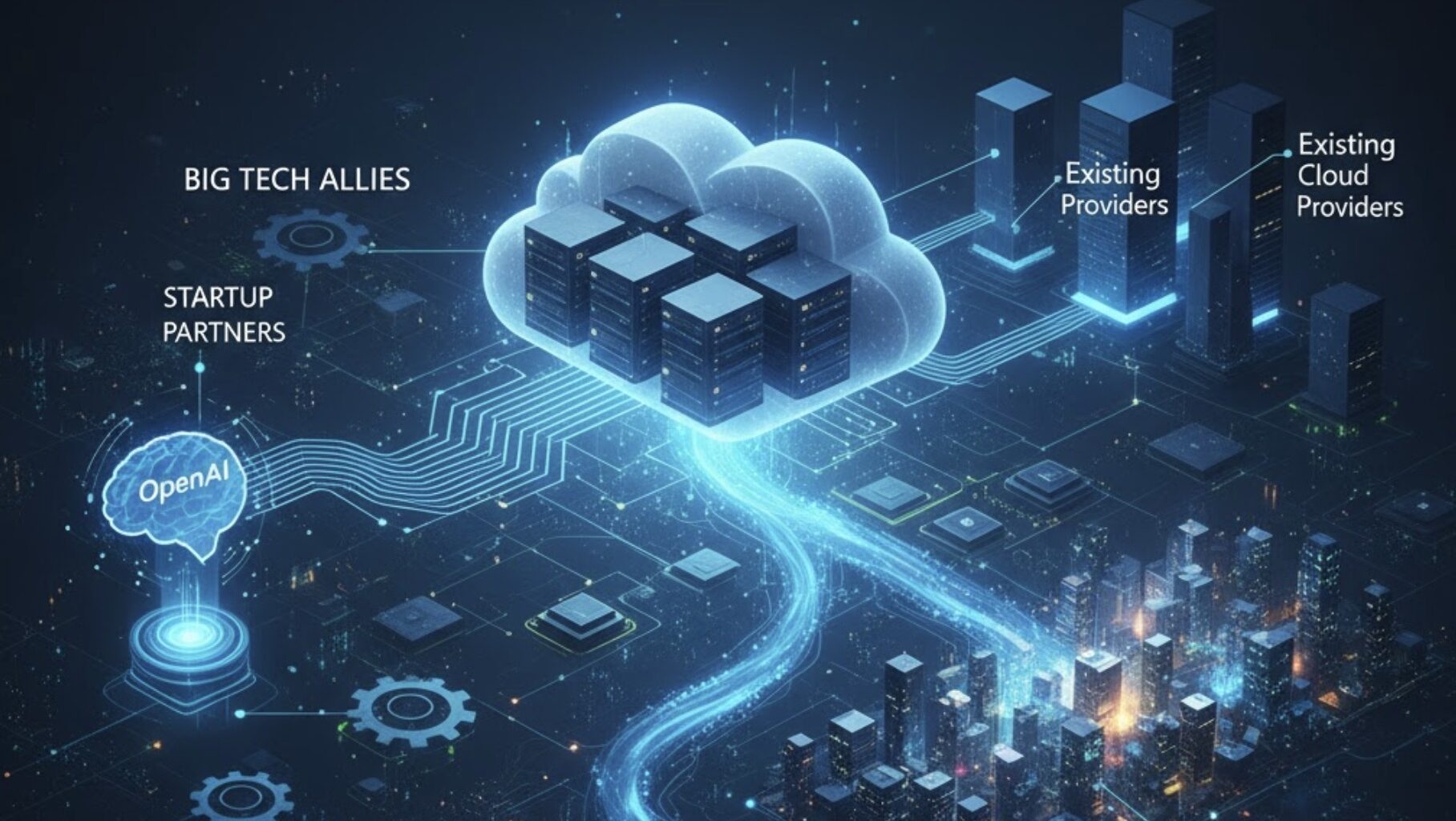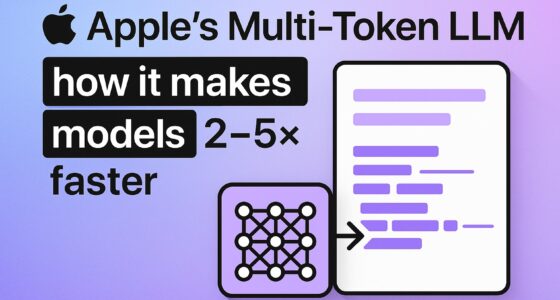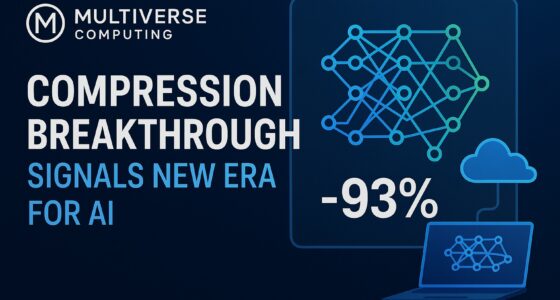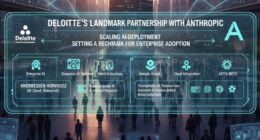OpenAI’s Cloud Ambitions and Infrastructure Shift
OpenAI is transitioning from being solely a customer of cloud providers to building and owning its own AI supercomputing infrastructure at unprecedented scale. The company historically relied on Microsoft Azure as its primary data center backend, under an exclusive partnershipfoxbusiness.com. However, in early 2025 OpenAI announced the “Stargate Project”, a massive initiative to invest $500 billion over four years into new data centers dedicated to AIopenai.comthorstenmeyerai.com. This project is structured as a joint venture led by SoftBank (financing) and OpenAI (operations), with initial equity from SoftBank, OpenAI, Oracle, and Abu Dhabi’s MGXopenai.comthorstenmeyerai.com. The goal is to build roughly 10 gigawatts (GW) of cutting-edge compute capacity across multiple U.S. sites, an unprecedented expansion aimed at securing leadership in advanced AIthorstenmeyerai.comstrongmocha.com. OpenAI has already broken ground on these data centers – for example, a flagship campus in Texas is operational – and by September 2025 the program had ~7 GW planned and ~$400 billion funded, putting it ahead of schedule toward the full 10 GW / $500 billion commitmentthorstenmeyerai.com. In short, OpenAI is rapidly evolving into a cloud infrastructure provider in its own right, positioning itself to potentially rival or even surpass today’s giants (AWS, Azure, Google Cloud) in AI-focused compute capacity.
Massive Infrastructure Deals Fueling OpenAI’s Cloud Push
OpenAI’s strategy for building out its cloud infrastructure involves deep partnerships with chipmakers and cloud providers, as illustrated by the connection between OpenAI (center) and key partners NVIDIA, AMD, and Oracle. These partnerships aim to overcome bottlenecks in AI compute by securing cutting-edge hardware and co-developing new data center capacity. In effect, OpenAI is aligning with industry leaders to finance and supply the enormous compute needs of next-generation AI models, rather than solely renting capacity from existing clouds. The key mega-deals driving this transformation include:
- NVIDIA’s $100 Billion Commitment: In September 2025, OpenAI and NVIDIA unveiled a strategic plan to deploy at least 10 GW of NVIDIA GPU systems to power OpenAI’s next-generation modelsstrongmocha.com. NVIDIA intends to invest up to $100 billion in OpenAI, released in stages as each 1 GW of data center capacity comes onlinestrongmocha.com. The first 1 GW is slated for late 2026 on NVIDIA’s new “Vera Rubin” platform. This unprecedented deal helps OpenAI lock in a massive supply of GPUs and associated financing, ensuring that GPU availability will not be a limiting factor for OpenAI’s model training at scalestrongmocha.com.
- AMD Chip Supply & Equity Deal: In October 2025, AMD and OpenAI announced a multi-year agreement for hundreds of thousands of AI accelerators, targeting roughly 6 GW of additional capacity starting in late 2026strongmocha.com. Uniquely, AMD granted OpenAI a warrant to purchase up to 160 million AMD shares (about 10% of AMD equity) at a nominal $0.01 per share, vesting in tranches tied to delivery and performance milestonesstrongmocha.com. In essence, if OpenAI’s partnership helps drive the success of AMD’s next-gen MI-series AI chips, OpenAI can acquire a significant stake in AMD at virtually no cost. This aligns incentives on both sides: OpenAI secures a second source of cutting-edge chips (diversifying beyond NVIDIA), and AMD wins a marquee customer with a shared interest in its successstrongmocha.com.
- Oracle Cloud Collaboration: Oracle has emerged as a key cloud partner in OpenAI’s infrastructure expansion. In mid-2024, OpenAI (along with Microsoft) selected Oracle Cloud Infrastructure (OCI) to extend its Azure capacity, effectively tapping Oracle’s data centers for additional AI workloadsthorstenmeyerai.com. By 2025, Oracle deepened this relationship by joining the Stargate project – notably, in July 2025 Oracle and OpenAI agreed to co-develop 4.5 GW of new AI data center capacity in the U.S., a partnership valued at over $300 billion in cloud services over five yearsthorstenmeyerai.com. Oracle is building multiple sites for OpenAI and was an initial equity investor in Stargate, making it one of OpenAI’s most significant infrastructure collaboratorsthorstenmeyerai.com. This deal caught many by surprise, signaling Oracle’s ambition to challenge larger cloud rivals by catering to OpenAI’s enormous AI compute needs.
- “Stargate” Infrastructure Consortium: Announced in January 2025, Stargate is the umbrella program for OpenAI’s data center build-out, backed by a consortium of tech and finance partnersthorstenmeyerai.com. SoftBank’s CEO Masayoshi Son serves as Stargate’s chairman, reflecting SoftBank’s role as lead financier, while OpenAI directs operationsopenai.com. Key technology partners include NVIDIA (providing GPU systems), Microsoft (supporting via Azure know-how), Arm (for chip architecture input), Oracle, and othersthorstenmeyerai.com. The scale – $500 billion and ~10 GW – is so large that it represents a fundamental shift in how AI projects are funded: moving from renting cloud services to capital-intensive infrastructure investmentstrongmocha.com. If executed fully, Stargate will create an AI supercomputing network on U.S. soil that could outsize any single cloud provider’s current AI capacity, underscoring OpenAI’s intent to surpass traditional cloud platforms in this domain.
These deals collectively provide OpenAI with the hardware, energy, and capital to build a bespoke cloud for AI. They also indicate a multi-vendor strategy – OpenAI is not betting on one supplier alone, but rather securing long-term commitments from both NVIDIA and AMD for chips, from Oracle (and even Google Cloud) for datacenter capacity, and from strategic investors like SoftBank for fundingthorstenmeyerai.comthorstenmeyerai.com. This reduces risk of dependency on any single partner and creates competitive leverage. In effect, OpenAI is leveraging the resources of established tech giants to accelerate its own infrastructure goals, while those partners gain a stake in OpenAI’s growth (for example, through equity warrants or massive cloud contracts).
Technical and Strategic Impacts of Owning the Infrastructure
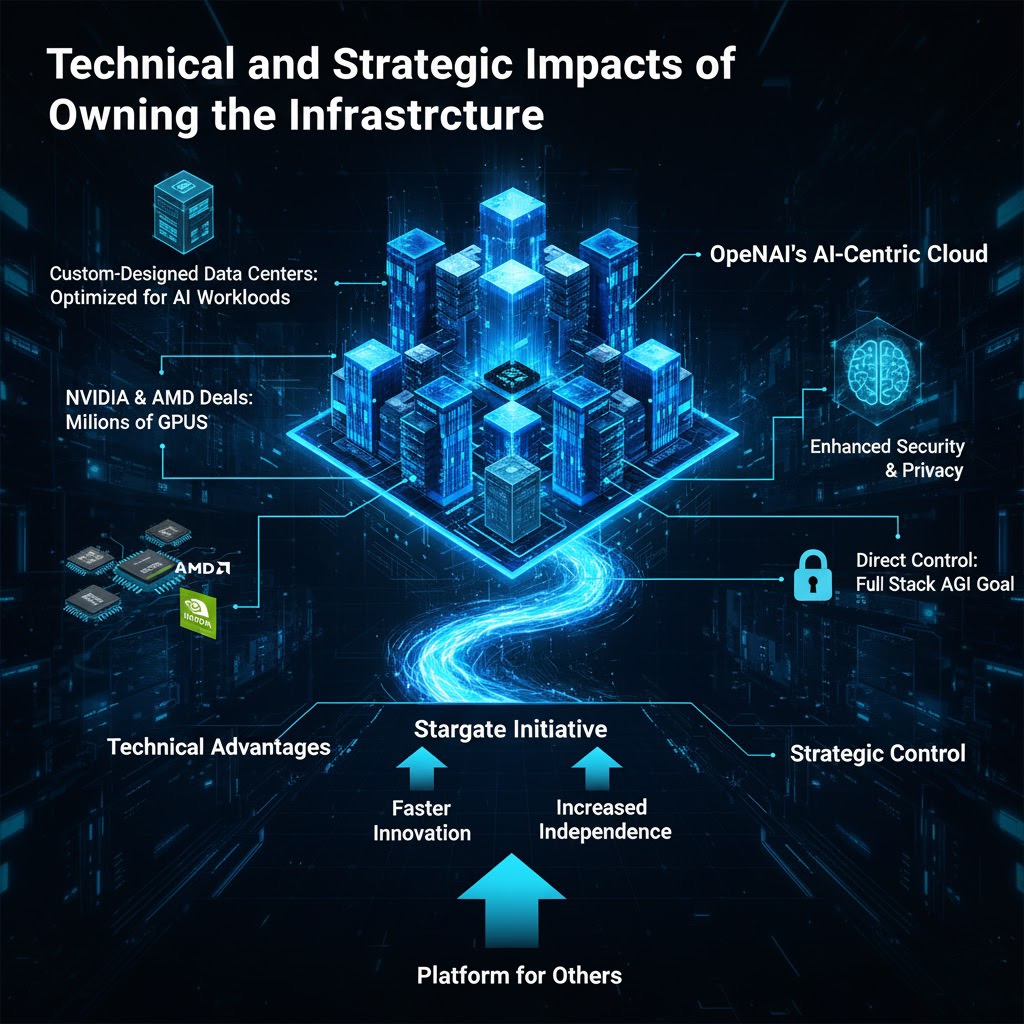
OpenAI’s pivot to owning infrastructure brings several technical advantages. First, it ensures dedicated compute capacity at scale for OpenAI’s research and services. By securing “millions of GPUs” worth of compute through NVIDIA and AMD deals, OpenAI can bypass the supply constraints that often affect AI projectsstrongmocha.com. It will be able to schedule model training and deployment on its own timetable rather than competing for time on third-party clouds. Second, custom-designed data centers can be optimized for AI workloads – from networking architecture to cooling and power distribution – potentially yielding better performance and efficiency for training large models. OpenAI can also integrate new hardware faster, for example rapidly deploying NVIDIA’s latest GPUs or AMD’s MI-series accelerators in its facilities, fine-tuned to its model requirements. This tight integration of hardware and software (similar to how e.g. Google uses TPUs in its cloud) could improve model training times and lower per-unit costs over time.
Strategically, owning infrastructure increases OpenAI’s independence and control. It is no longer beholden to a single cloud vendor’s pricing, availability, or technical limitations. OpenAI’s CEO Sam Altman and team have explicitly framed this build-out as critical to achieving their long-term goal of artificial general intelligence, implying they want direct control over the “full stack” powering their AIopenai.comopenai.com. By controlling data centers, OpenAI also keeps sensitive model training data in-house (rather than on a third-party platform), which can enhance security and privacy. Moreover, the huge scale of Stargate – with backing from sovereign wealth (MGX) and tech giants – gives OpenAI a strategic asset that few companies in the world possess. In essence, OpenAI is creating an AI-centric cloud that it owns, which could eventually serve as a platform for others as well (not unlike how Amazon built AWS initially for itself and then opened it to customers).
There are also risks and challenges. Building and operating data centers is capital- and labor-intensive. OpenAI will be entering the business of facilities management, power procurement, and hardware maintenance – areas traditionally handled by cloud providers. Ensuring reliable uptime and dealing with issues like cooling “hot” GPU clusters at 10 GW scale are non-trivial challenges. However, OpenAI is mitigating this by partnering with experienced players (Oracle for data center construction/operations, power companies via its RFPs for land and energyopenai.com, etc.). Another challenge is that technology can rapidly evolve – OpenAI’s investment assumes current GPU-based architectures remain key for the next 4+ years. If radically new paradigms (quantum computing or new AI chips) emerged, large fixed infrastructure might need adaptation. Still, given current trends, high-performance GPU and accelerator farms are likely to remain the backbone of AI compute into the late 2020s.
In summary, technically OpenAI’s own cloud should give it unparalleled compute horsepower tailored to its needs, and strategically it cements OpenAI’s autonomy in pursuing cutting-edge AI. This positions OpenAI not just as an AI research lab or software provider, but increasingly as an integrated tech platform controlling everything from silicon up to the user-facing AI applications.
Impact on Existing Partnerships (Microsoft and Others)
OpenAI’s move into hosting inevitably reshapes its relationships with existing cloud partners, especially Microsoft. Microsoft invested $1 billion in OpenAI in 2019 and another $10 billion in early 2023, securing exclusive rights to provide cloud computing (Azure) for OpenAI and to resell OpenAI’s AI services on Azurefoxbusiness.com. That exclusive arrangement has now evolved. In 2023–2024, as OpenAI plotted its own infrastructure path, Microsoft renegotiated terms to allow OpenAI’s Stargate initiative and multi-cloud deals to proceedfoxbusiness.com. According to reports, Microsoft agreed to adjust its exclusivity so that OpenAI could engage in ~$300 billion in long-term cloud contracts with Oracle and even strike a cloud deal with Googlefoxbusiness.com. This marks a significant shift from Microsoft being the sole compute provider to OpenAI now operating in a multi-cloud, multi-partner regime.
Crucially, Microsoft remains a close partner – OpenAI’s announcement of Stargate explicitly stated that it “builds on the existing OpenAI partnership with Microsoft” and that OpenAI will continue to increase its consumption of Azure alongside the new infrastructureopenai.com. In practice, this means Microsoft’s Azure will still host OpenAI services and provide capacity (particularly for serving customers via the Azure OpenAI Service), but Azure is no longer the only game in town for OpenAI’s compute. Strategically, Microsoft may benefit from OpenAI’s growth in other ways: Microsoft’s investment gains value as OpenAI’s valuation soars, and Microsoft’s Azure can still be used for certain workloads or geographic regions even as OpenAI’s own data centers come online. However, there is potential competitive tension on the horizon. If OpenAI’s cloud becomes capable of offering AI hosting services to third parties, it could compete with Microsoft’s Azure AI offerings or reduce Azure’s future revenue from OpenAI’s usage. Microsoft’s advantage is that it has a broad enterprise customer base and can integrate OpenAI’s models into its products (like Office copilot, Bing, etc.), whereas OpenAI’s nascent cloud would be highly specialized for AI tasks.
Other cloud players are also touched by OpenAI’s moves. Google was reportedly approached by OpenAI – indeed, OpenAI quietly inked a deal to use Google Cloud infrastructure for some needsfoxbusiness.com. This is striking given Google is an AI competitor (with DeepMind and its own models) but shows that OpenAI is willing to spread its workload for resilience and capacity. Google’s cooperation might be limited (and likely focused on specific areas like YouTube data analysis or similar, according to speculation), but it indicates a more coopetition dynamic in the industry where even rivals partner in certain areas. Meanwhile, Amazon’s AWS is notably not (publicly) a partner of OpenAI. Instead, AWS has aligned with Anthropic (another AI startup) via a $4 billion investment in late 2023, perhaps to ensure it has a stake in a major AI customer as OpenAI tilts toward Azure/Oracle and its own centersaa.com.tr. Oracle’s deep partnership with OpenAI clearly puts Oracle in a stronger position against rivals in the cloud market, at least for high-end AI workloads – Oracle’s stock even jumped on news of the OpenAI deals, underscoring how significant the cloud industry views these shifts.
In summary, OpenAI’s emergence as an infrastructure player has rebalanced its alliances: Microsoft remains an ally but no longer holds a monopoly over OpenAI’s cloud needs, Oracle has vaulted into a first-tier partner role, and others like Google are involved at the margins. For Microsoft, this required flexibility (renegotiating exclusivity) to maintain the relationship. Going forward, OpenAI’s partners may find themselves both collaborating and competing with OpenAI: collaborating to build the infrastructure and integrate AI services, but potentially competing if OpenAI’s cloud starts attracting workloads that might otherwise go to Azure, AWS, or Google Cloud. This delicate balance will likely continue as long as OpenAI delivers unique AI capabilities that the big players want access to.
Economic and Market Implications in the Cloud Ecosystem
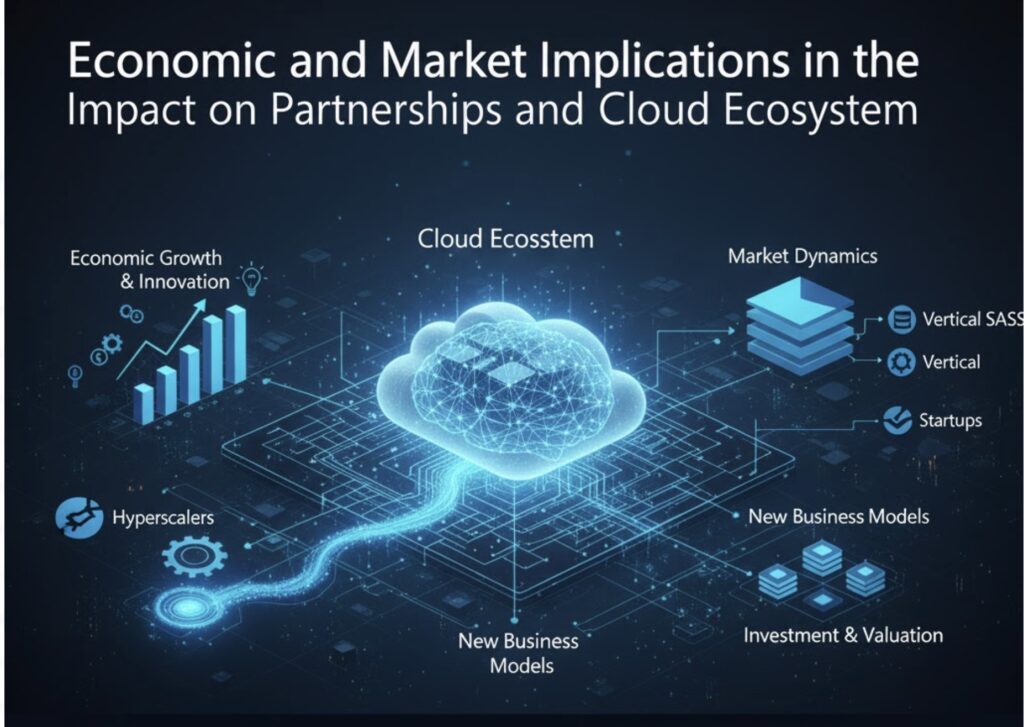
The economic stakes of OpenAI becoming a cloud (hosting) provider are enormous. Cloud computing is a hundreds-of-billions of dollars market annually, and AI workloads are the fastest-growing segment of that market. By internalizing its hosting, OpenAI stands to retain more value from the services it provides. Instead of paying Microsoft or Amazon a significant margin on cloud rentals, OpenAI’s capital investments will pay off over time through lower marginal costs for compute (once infrastructure is built, the cost per training or inference hopefully drops). This could improve OpenAI’s profitability in delivering AI services like ChatGPT, the API, or new products, as it won’t be sharing as much revenue with cloud landlords. It’s a play similar to large tech companies (like Apple building its own chip fabrication plans to reduce dependence on suppliers): large up-front costs for long-term efficiency and control.
OpenAI’s aggressive build-out, if successful, also means it could offer cloud services externally, disrupting the market shares of incumbents. Today, organizations that need AI model hosting or training often go to AWS, Azure, or specialized providers like CoreWeave. In fact, OpenAI itself has been using firms like CoreWeave (an AI-focused cloud startup) for model training – deals valued at ~$22 billion were signed for CoreWeave to provide OpenAI cloud capacity in 2023aa.com.tr. Once OpenAI’s own datacenters come online, it may scale back such third-party contracts, impacting those suppliers. Furthermore, OpenAI might start to compete for enterprise and government AI workloads. With a half-trillion-dollar infrastructure, OpenAI could create an AI cloud platform optimized for its models and possibly for customer-specific models. This would put it in direct competition with Amazon, Microsoft, and Google on a key frontier – providing the infrastructure for AI-driven innovation in other companies. OpenAI’s brand and technological lead in AI could attract customers to its platform, especially if it offers seamless integration with OpenAI’s models or better performance/price for AI tasks than generalist clouds. In essence, OpenAI could draw away some market share in cloud computing, focusing on the lucrative AI segment.
We should note, however, that surpassing AWS or Azure in the general cloud market would be a monumental challenge – those platforms offer thousands of services and have deep enterprise ties. OpenAI is likely to specialize in what it knows best (AI model training and inference). Even so, the growth of AI means that specialization covers a huge opportunity. Global AI spending is expected to reach $375 billion in 2025 and $500 billion in 2026aa.com.tr, and cloud providers are racing to capture that. If OpenAI grabs a significant piece, it could indeed leapfrog some incumbents in terms of AI cloud market share. Notably, OpenAI’s current valuation – around $500 billion after a recent share salethorstenmeyerai.comthorstenmeyerai.com – reflects investor belief that OpenAI will dominate large swathes of the AI value chain. That valuation makes it the world’s most valuable private tech company, ahead of SpaceX, and roughly half the market cap of Google or Microsoftthorstenmeyerai.com. It implies that OpenAI is expected not just to make AI models, but to monetize them at massive scale, potentially by being the platform on which much AI activity happens.
For the broader market, this development injects more competition and innovation. Cloud giants will likely respond by enhancing their own AI offerings (as we’ve seen with Amazon investing in Anthropic, Microsoft boosting its Azure AI supercomputing, Google with its TPUs and Vertex AI service). It could also lead to interesting pricing dynamics – for instance, if OpenAI’s cloud ends up offering lower prices for AI compute to attract users, other clouds might have to adjust pricing for GPU instances. Economically, the investment itself (Stargate’s $500B) is a huge stimulus, creating jobs in construction, chip manufacturing (NVIDIA, AMD ramps), and renewable energy (powering these datacenters). OpenAI’s move also signals that AI-specific infrastructure is becoming a strategic asset, much like oil refineries were in the industrial age. This might encourage others to co-invest in dedicated AI compute (we see Meta, Google building their own too), or conversely, some might rely on OpenAI’s capacity rather than duplicating it.
In summary, OpenAI becoming a hosting provider could capture a large chunk of the AI cloud economy for itself, altering the competitive landscape. It heightens the rivalry but also partnership between OpenAI and traditional clouds, and it underscores that, in the AI era, control over computing power is as critical as control over algorithms and data. Economically, if OpenAI executes well, it stands to reap huge rewards by being both the AI model innovator and the service platform, a combination that could justify the sky-high valuation it has recently attainedthorstenmeyerai.comthorstenmeyerai.com.
Serving Europe: Sovereignty and Local Cloud Considerations
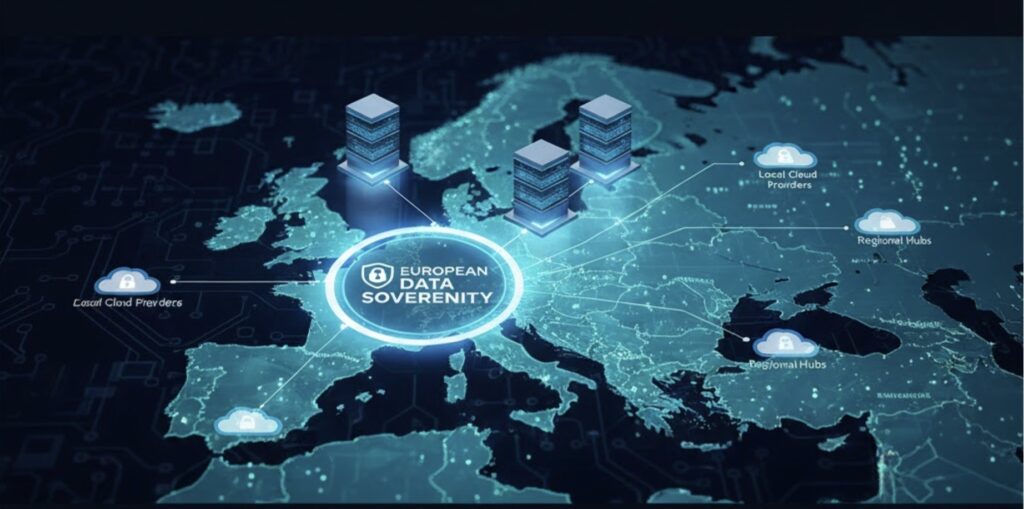
As OpenAI expands its infrastructure globally, a key question is how it will serve Europe, a market with strong requirements for digital sovereignty. In recent years, Europe’s cloud and AI strategy has pivoted towards reducing reliance on foreign (mainly U.S.) providers and ensuring European control over data and compliance. In fact, Europe’s cloud and AI markets are “splitting from Silicon Valley’s gravitational pull”, driven by new regulations and a push for self-reliancestrongmocha.com. The EU has introduced strict laws – notably the EU AI Act and the Data Governance Act – which demand traceability of AI models and data, and impose European oversight on AI systemsthorstenmeyerai.comthorstenmeyerai.com. Sovereign AI is no longer just a slogan; it’s becoming the “operating system” of Europe’s digital economythorstenmeyerai.com, meaning any AI service provider must adapt to these rules if they wish to operate widely in Europe.
European nations are actively building sovereign cloud ecosystems that keep data and compute within EU borders under EU jurisdiction. For example, Germany launched an “OpenAI for Germany” initiative: OpenAI’s models (like GPT-4) are being deployed for the German public sector via a partnership between SAP and Microsoft’s Delos Cloud, running on a sovereign-compliant Azure frameworkthorstenmeyerai.com. This is considered the first true sovereign deployment of OpenAI tech for a national government. France, similarly, has the “Bleu” cloud project (a joint venture of Orange, Capgemini, and Microsoft) delivering Azure services under French control (SecNumCloud certified)thorstenmeyerai.com. At the same time, French startup Mistral AI has risen as a home-grown champion building large language models, valued at €11.7 billion, reflecting Europe’s desire for its own AI capabilitythorstenmeyerai.com. Other examples: Spain is developing Spanish-language AI models with IBM and installing NVIDIA GPUs at telecom provider Telefónica for local AI inferencingstrongmocha.com; Italy is investing €4.3 billion with Microsoft in cloud expansion and supporting local AI like the CINECA supercomputer and Fastweb’s modelsstrongmocha.comthorstenmeyerai.com. Even the Netherlands has ASML (critical in chipmaking) investing in AI startups like Mistral, linking Europe’s chip industry with AI developmentstrongmocha.com.
What this means for OpenAI is that simply offering its services from U.S. or non-EU data centers may not satisfy European governments or certain industries. OpenAI, with its own infrastructure now, might consider building data centers in Europe or partnering with European cloud providers to establish EU-sovereign instances of its platform. We have a glimpse of this in the German case, where OpenAI’s service is delivered via a local cloud under EU governance rules. Hyperscalers are already doing this: Microsoft is scaling up “national cloud” partnerships (like the French Bleu and German Delos), AWS is building a fully isolated European Sovereign Cloud region, and Google Cloud partners with Thales and T-Systems for EU-compliant offeringsstrongmocha.com. OpenAI could follow a similar path – for instance, working with a European company or consortium to host OpenAI’s models on European soil with EU-only data access controls. Such a setup would alleviate concerns about U.S. jurisdiction (like the U.S. CLOUD Act) over European data, which is a core issue in sovereignty debates.
Europe’s regulators and initiatives like Gaia-X will also influence OpenAI’s approach. Gaia-X is creating a framework for certifying cloud providers who meet EU standards and enabling interoperability between cloudsstrongmocha.com. If OpenAI wants to be a hosting provider in Europe, getting a “Gaia-X” label or equivalent might become important to reassure customers that using OpenAI’s cloud won’t violate sovereignty requirements. Additionally, under the EU AI Act, high-risk AI systems will need to be audited and potentially registered; OpenAI might have to allow European agencies to inspect its models or training data for compliance. This could push OpenAI to set up more localized operations (perhaps even a European subsidiary that controls the local cloud infrastructure and data, to create a legal firewall from the U.S. entity).
On the other hand, Europe’s sovereignty push also implies the rise of European competitors or alternatives that OpenAI will need to contend with. While no European model is yet as powerful as GPT-4 or GPT-5, initiatives like Mistral, Aleph Alpha (in Germany), or open-source models backed by EU projects aim to offer privacy-compliant, transparent AI suited to European valuesstrongmocha.com. By 2030, Europe envisions a federated network of sovereign clouds hosting a library of European AI models, with a hybrid approach of “U.S. technology under EU operational control alongside home-grown models”thorstenmeyerai.com. In this scenario, Europe could set the global benchmark for regulated, trustworthy AI innovationstrongmocha.com. For OpenAI, aligning with this trend could be beneficial – if OpenAI’s infrastructure in Europe operates under European oversight and helps Europe meet its goals, OpenAI can capture a significant market share without provoking regulatory backlash. If not, OpenAI risks being seen as a non-compliant outsider, which could drive European customers to prefer “sovereign” solutions.
In practical terms, we may see OpenAI mirror the hyperscalers: possibly announcing new European data center investments or partnerships as part of its hosting expansion. Already, the fact that SAP’s Delos Cloud is deploying OpenAI services shows OpenAI’s willingness to adapt its model delivery to local requirementsthorstenmeyerai.com. As OpenAI’s own infrastructure matures, it could deploy a portion of its 10 GW capacity in Europe (or dedicate some of it via remote isolation) to specifically serve European clients under EU rules. Such moves would not only satisfy government customers but also large private EU companies in sectors like finance or healthcare that require data residency and compliance.
In summary, Europe’s sovereign cloud push presents both a challenge and an opportunity for OpenAI-as-a-cloud-provider. The challenge is adapting to a fragmented regulatory environment and possibly duplicating infrastructure for local control; the opportunity is that OpenAI, by providing a compliant AI platform, could become the de facto choice for AI needs across Europe if it earns the trust of regulators. Europe is quietly reshaping the power dynamic in favor of those who can guarantee privacy, security, and compliancethorstenmeyerai.comthorstenmeyerai.com – OpenAI’s future success in the European market will depend on its ability to operate within that framework while still leveraging its unique AI capabilities.
Conclusion
OpenAI’s evolution into a hosting and cloud infrastructure provider marks a pivotal shift in the tech industry. It signals that to lead in AI, a company must also innovate in infrastructure and secure control over the computing power that fuels AI breakthroughs. By forging mega-deals with NVIDIA, AMD, Oracle, and others, OpenAI has marshaled the resources to build an AI-centric cloud of unprecedented scale – one that could rival or surpass the AI capacity of established cloud playersstrongmocha.comthorstenmeyerai.com. This move stands to reshape OpenAI’s relationships: it remains partnered with firms like Microsoft, but on a more equal footing where OpenAI holds its own assets. Economically, it positions OpenAI to capture more value and potentially draw customers into its ecosystem, intensifying competition in the cloud market.
Crucially, as OpenAI expands globally, it will have to navigate regional dynamics such as Europe’s demand for digital sovereignty. Success will require not just raw computing power, but flexibility in governance and compliance. If OpenAI can integrate its cloud services into local frameworks (as it has started doing in Europethorstenmeyerai.com), it can become an even more dominant player worldwide, serving as the backbone for AI innovation across continents. The strategy of becoming a hosting provider underscores OpenAI’s confidence in its vision – it is effectively betting that its AI models and platform will be so foundational in the coming era that owning the “factory” (the cloud that produces and delivers AI) is worth the colossal investment.
In the big picture, OpenAI’s cloud ambitions might herald a new competitive paradigm: one where traditional cloud titans are challenged by an AI-first upstart that controls both AI software and the specialized hardware infrastructure. Whether OpenAI eventually surpasses today’s cloud giants remains to be seen, but the trajectory is set. The company’s value has skyrocketed to the half-trillion mark on the expectation that it will fundamentally change how AI is deliveredthorstenmeyerai.comthorstenmeyerai.com. With its own hosting infrastructure coming online, OpenAI is poised to accelerate AI development and adoption – and in doing so, it is reshaping the technical, economic, and strategic landscape of the cloud market before our eyes.
Sources: OpenAI announcements; Thorsten Meyer’s analysis of OpenAI’s partnershipsthorstenmeyerai.comthorstenmeyerai.com; Fox Business and Reuters reports on OpenAI’s valuation and Microsoft partnership changesfoxbusiness.comthorstenmeyerai.com; StrongMocha insights on Europe’s sovereign cloud initiativesstrongmocha.comthorstenmeyerai.com; and additional industry reports.
